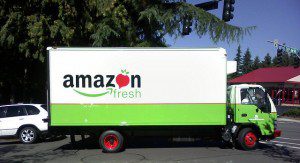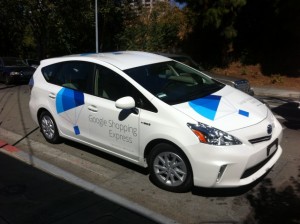Amazon, Google, and Crowdsourcing: The Battle for the Last Mile
There has been a lot of talk lately as it relates to “last mile” deliveries, and how retailers can delight their customers at the actual moment of fulfillment. As more retailers venture into the omni-channel space, last mile has taken on more importance. Two behemoths have taken center stage in the battle for perfecting (or at least improving) the last mile for customers: Amazon and Google.
For many people, Amazon is the end-all, be-all for their shopping needs. With nearly 60 (and counting) distribution centers in the United States, Amazon can fulfill orders quickly to nearly every square inch of the country. With Amazon Prime, and its $99 a year price tag, customers can receive these orders in two days, guaranteed. But two day delivery isn’t the only perk of Prime. Amazon Prime customers have access to a growing catalog of e-books, and streaming digital music and video, including a new partnership with HBO.

But controlling the last mile is more important than ever. So Amazon is rolling out its own fleet of delivery trucks. These trucks become a true competitor to UPS and FedEx, which will surely miss the Amazon business. For Amazon, it adds control over the last mile, and who is actually delivering the merchandise to customers. It also creates some additional flexibility into delivery timeframes, which can increase customer satisfaction. At the same time, it offers a way to reduce shipping costs, which have been increasingly as a larger percentage of revenue every year since 2009.
 Enter Google, and its desire to play in the last mile game. Google’s model is different than Amazon. Google does not have distribution centers around the country, nor does it want to. Instead, Google contracts directly with local stores to provide same-day delivery (mostly). The advantage for Google here is that it can keep adding new partners without worrying about inventory carrying costs. As part of Google’s Shopping Express, customers can sign in through their Google account, use their Google Wallet to pay for the purchase, and select a delivery timeframe. Overnight deliveries are offered in select areas where same-day delivery is not offered.
Enter Google, and its desire to play in the last mile game. Google’s model is different than Amazon. Google does not have distribution centers around the country, nor does it want to. Instead, Google contracts directly with local stores to provide same-day delivery (mostly). The advantage for Google here is that it can keep adding new partners without worrying about inventory carrying costs. As part of Google’s Shopping Express, customers can sign in through their Google account, use their Google Wallet to pay for the purchase, and select a delivery timeframe. Overnight deliveries are offered in select areas where same-day delivery is not offered.
There is also a third option for retailers to deliver their goods to the end consumer, without going the traditional route of using UPS, FedEx, or USPS: crowdsourcing. Crowdsourcing has taken off in recent years. Companies like Uber and Lyft are changing the livery market, and making life more challenging for traditional taxi companies. Crowdsourced hospitality sites like Airbnb and VRBO are changing the way people travel. And now retailers can jump on the bandwagon too.
Companies like Deliv and Kanga are expanding delivery options for retailers. Deliv, for example, uses an API to create a same day shipping option for e-commerce customers. At check-out, there is a new question – “would you like this order delivered?” The price for same day delivery is the same as standard 3 – 5 day delivery in most cases. The big thing for retailers is to ensure safe delivery of the merchandise. That’s why these companies have a rigorous screening process prior to certification, including background checks, interviews, insurance coverage, and vehicle checks.
The last mile is the last chance retailers get to influence the final leg of the customer experience. Offering same day delivery to customers is one more way to leave them with a good taste in their mouth about the experience as a whole. Amazon and Google have entered into an arms race to roll out their own fleets to provide this last touch-point. And while customers have taken notice, so have enterprising minds. The rise of crowdsourced options for the last mile is the next logical step in ensuring quick, efficient deliveries. It also shows that consumers are willing to pay for same day delivery. In those markets where Google and Amazon do not offer same day delivery, the opportunity for a crowdsourced model is huge. And as these models grow, it will be interesting to see how Amazon and Google respond. Will they turn to innovation mode or acquisition mode? Only time will tell.
For many people, Amazon is the end-all, be-all for their shopping needs. With nearly 60 (and counting) distribution centers in the United States, Amazon can fulfill orders quickly to nearly every square inch of the country. With Amazon Prime, and its $99 a year price tag, customers can receive these orders in two days, guaranteed. But two day delivery isn’t the only perk of Prime. Amazon Prime customers have access to a growing catalog of e-books, and streaming digital music and video, including a new partnership with HBO.

But controlling the last mile is more important than ever. So Amazon is rolling out its own fleet of delivery trucks. These trucks become a true competitor to UPS and FedEx, which will surely miss the Amazon business. For Amazon, it adds control over the last mile, and who is actually delivering the merchandise to customers. It also creates some additional flexibility into delivery timeframes, which can increase customer satisfaction. At the same time, it offers a way to reduce shipping costs, which have been increasingly as a larger percentage of revenue every year since 2009.
 Enter Google, and its desire to play in the last mile game. Google’s model is different than Amazon. Google does not have distribution centers around the country, nor does it want to. Instead, Google contracts directly with local stores to provide same-day delivery (mostly). The advantage for Google here is that it can keep adding new partners without worrying about inventory carrying costs. As part of Google’s Shopping Express, customers can sign in through their Google account, use their Google Wallet to pay for the purchase, and select a delivery timeframe. Overnight deliveries are offered in select areas where same-day delivery is not offered.
Enter Google, and its desire to play in the last mile game. Google’s model is different than Amazon. Google does not have distribution centers around the country, nor does it want to. Instead, Google contracts directly with local stores to provide same-day delivery (mostly). The advantage for Google here is that it can keep adding new partners without worrying about inventory carrying costs. As part of Google’s Shopping Express, customers can sign in through their Google account, use their Google Wallet to pay for the purchase, and select a delivery timeframe. Overnight deliveries are offered in select areas where same-day delivery is not offered.There is also a third option for retailers to deliver their goods to the end consumer, without going the traditional route of using UPS, FedEx, or USPS: crowdsourcing. Crowdsourcing has taken off in recent years. Companies like Uber and Lyft are changing the livery market, and making life more challenging for traditional taxi companies. Crowdsourced hospitality sites like Airbnb and VRBO are changing the way people travel. And now retailers can jump on the bandwagon too.
Companies like Deliv and Kanga are expanding delivery options for retailers. Deliv, for example, uses an API to create a same day shipping option for e-commerce customers. At check-out, there is a new question – “would you like this order delivered?” The price for same day delivery is the same as standard 3 – 5 day delivery in most cases. The big thing for retailers is to ensure safe delivery of the merchandise. That’s why these companies have a rigorous screening process prior to certification, including background checks, interviews, insurance coverage, and vehicle checks.
The last mile is the last chance retailers get to influence the final leg of the customer experience. Offering same day delivery to customers is one more way to leave them with a good taste in their mouth about the experience as a whole. Amazon and Google have entered into an arms race to roll out their own fleets to provide this last touch-point. And while customers have taken notice, so have enterprising minds. The rise of crowdsourced options for the last mile is the next logical step in ensuring quick, efficient deliveries. It also shows that consumers are willing to pay for same day delivery. In those markets where Google and Amazon do not offer same day delivery, the opportunity for a crowdsourced model is huge. And as these models grow, it will be interesting to see how Amazon and Google respond. Will they turn to innovation mode or acquisition mode? Only time will tell.

No comments:
Post a Comment